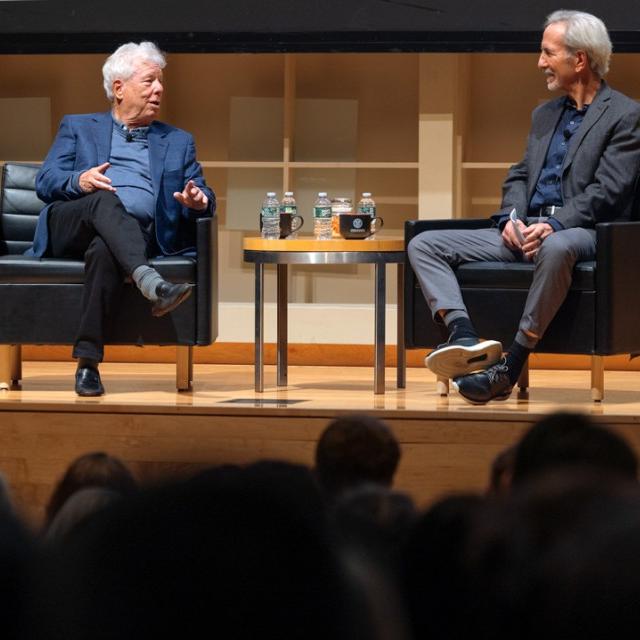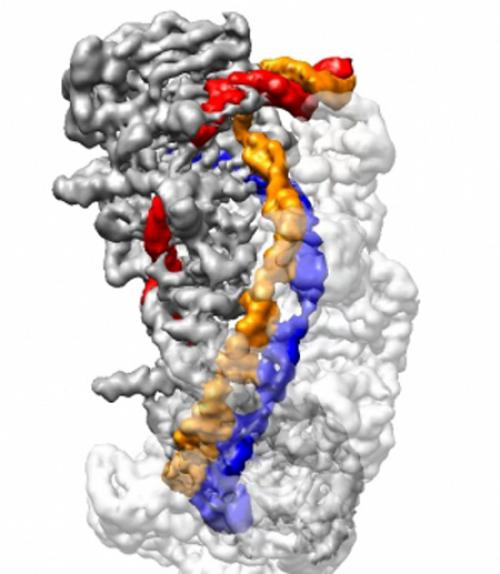By taking a series of near-atomic resolution snapshots, Cornell and Harvard Medical School scientists have observed step-by-step how bacteria defend against foreign invaders such as bacteriophage, a virus that infects bacteria.
The process they observed uses CRISPR (clustered regularly interspaced short palindromic repeats) sites, where the cell’s DNA can be snipped to insert additional DNA.
Biologists use CRISPR for genetic engineering experiments, but cells may have evolved the mechanism as part of a defense system. The cell uses these locations to store molecular memories of invaders so that they can be selectively eradicated at the next encounter.
“The bug’s immunity system works just as efficiently as ours, except our system functions at the protein recognition level, whereas CRISPR works at the nucleic acid recognition level,” explained Ailong Ke, professor of molecular biology and genetics.
Upon first encounter, the bacteria inserts a bit of an invader’s DNA into its own genome at the CRISPR location. When needed, an RNA transcript of the stored DNA, called guide RNA, can be assembled with other proteins into a complex called Cascade (CRISPR Associated Complex for Antiviral Defense). The system is so efficient and precise that researchers have thought of ways to re-tool it for genome editing applications, to introduce changes at precise locations of DNA. “A CRISPR revolution is sweeping through biology as we speak,” said Ke.
In previous research, Ke had defined the function of the protein-RNA complexes involved in the process and used the X-ray crystallography facilities of the Cornell High Energy Synchrotron Source (CHESS) to determine their structure. Yibei Xiao, a postdoctoral resesearcher in Ke’s lab worked out the entire immunity process, step by step. “The next step is to capture structural snapshots of these steps, to produce a high-definition movie of what’s going on,” said Ke.
Ke collaborated with Maofu Liao, assistant professor of cell biology at Harvard Medical School, who is an expert in using a cryo-electron microscope to determine high-resolution structures of macromolecules frozen in a thin layer of ice. Working with the bacteria Thermobifida fusca, used in fermentation, Ke’s lab prepared samples representing distinct stages of the immune response. Liao and his postdoctoral researcher Min Luo froze these samples and took high-resolution snapshots at each step. The study focused on a particular version of CRISPR-related defense known as Type I-E.
“We knew roughly how it works, but without the structures we didn’t have the details,” Ke said. “A picture is worth a thousand words.”
“Scientists hypothesized that these states existed but they were lacking the visual proof of their existence,” said Luo. “Now, seeing really is believing.”
They saw how the bacteria assembles the Cascade complex – a large protein that looks like a seahorse under the microscope – with a piece of guide RNA attached. When the guide finds viral DNA, the Cascade complex provides a mechanism to unwind the DNA double helix and get inside. The RNA locks onto its matching DNA to form an impenetrable “R-loop” that prevents the DNA from functioning. The process also changes the conformation of the Cascade protein in a way that attracts an enzyme called Cas3 that shreds the viral DNA beyond repair. The enzyme moves along the DNA like unzipping a zipper.
The system includes multiple layers of error detection to prevent chewing up its own DNA, the researchers said. “We’ve found that these steps must occur in a precise order,” Luo said. “Evolutionarily, this mechanism is very stringent and has triple redundancy, to ensure that this complex degrades only invading DNA.”
“The Type I-E system is one of the most well-studied systems across all the CRISPR research,” said Xiao, “but previously the resolution for the complex was very low, 8 angstrom; we’ve pushed it to near atomic resolution. Now we can talk about the process with great confidence. Our work beautifully explains the mechanism for how Cascade can recognize and open the foreign DNA. This is the first time we’ve seen this system. Biochemically it’s beautiful, like a textbook-style study.”
The findings, published June 29 in the journal Cell, provide structural data that can improve the efficiency and accuracy of biomedical CRISPR operations. Aspects of this defense mechanism – particularly how it searches for its DNA targets – were unclear and have raised concerns about unintended off-target effects and the safety of using the CRISPR-Cas mechanism for treating human diseases.
“To solve problems of specificity, we need to understand every step of CRISPR complex formation,” said Liao.
“To apply CRISPR in human medicine, we must be sure the system does not accidentally target the wrong genes,” said Ke. “Our argument is that the Type I system is potentially more accurate than CRISPR-Cas9, because it checks a longer stretch of sequence before action, and the system divides target searching and degradation into two steps, with built-in safety features in between.”
Type I CRISPR so far offers limited utility for precision gene editing, but it may be used as a tool to combat antibiotic-resistant strains of bacteria.
Ke and Xiao co-authored another paper in the same issue of Cell, with Ilya Finkelstein, assistant professor of molecular biosciences at the University of Texas at Austin, to characterize how Cascade searches for targets at the single molecule level.
“An unsung hero,” Ke added, “is the bug itself, Thermobifida fusca. CRISPR proteins from this bacteria behave extremely well, which enabled everything. The late Cornell professor David Wilson utilized the bacteria for biofuel production, and he provided the strain to us for free.”
This work is supported by the National Institutes of Health. CHESS is supported by the National Science Foundation.
This story also appeared in the Cornell Chronicle.





